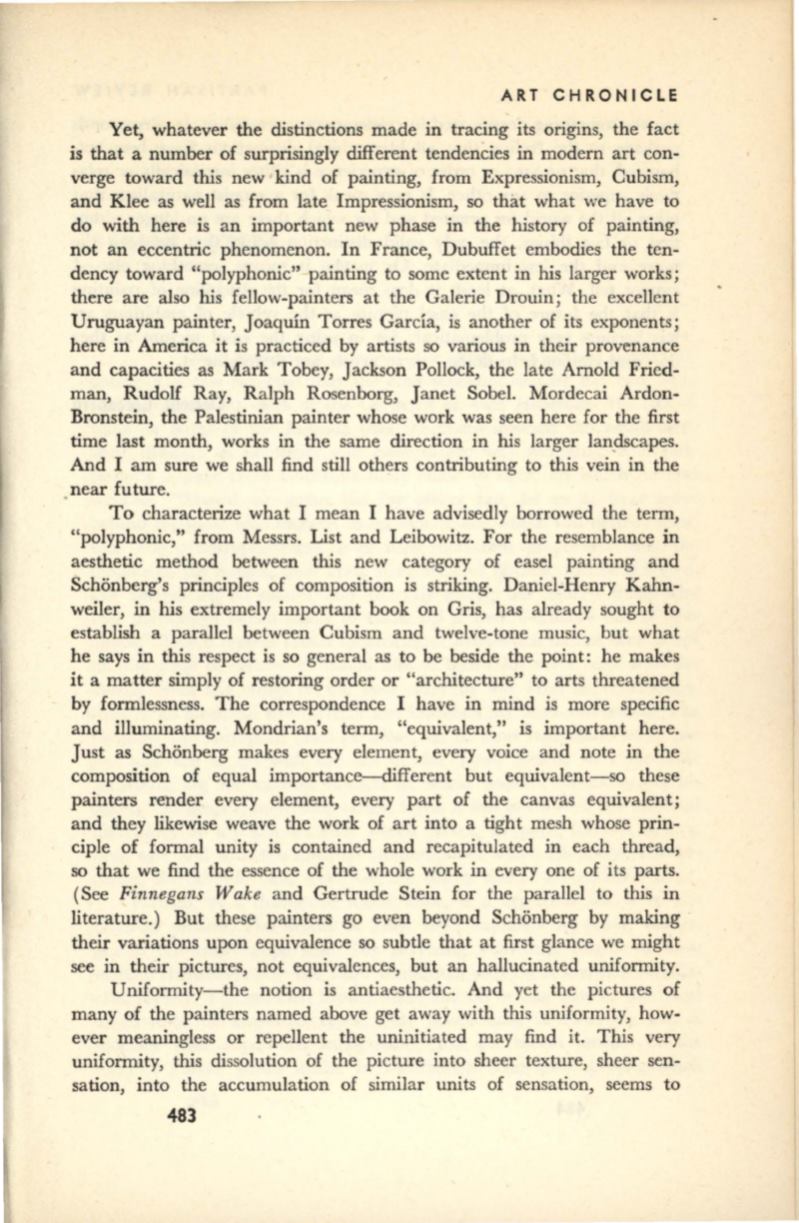
ART CHRONICLE
Yet, whatever the distinctions made in tracing its origins, the fact
is that a number of surprisingly different tendencies in modern art con–
verge toward this new kind of painting, from Expressionism, Cubism,
and Klee as well as from late Impressionism, so that what we have to
do with here is an important new phase in the history of painting,
not an eccentric phenomenon. In France, Dubuffet embodies the ten–
dency toward "polyphonic" painting to some extent in his larger works;
there are also his fellow-painters at the Galerie Drouin; the excellent
Uruguayan painter, Joaquin Torres Garcia, is another of its exponents;
here in America it is practiced by artists so various in their provenance
and capacities as Mark Tobey, Jackson Pollock, the late Arnold Fried–
man, Rudolf Ray, Ralph Rosenborg, Janet Sobel. Mordecai Ardon–
Bronstein, the Palestinian painter whose work was seen here for the first
time last month, works
in
the same direction in his larger lan_dscapes.
And I am sure we shall find still others contributing to this vein in the
near future.
To characterize what I mean I have advisedly borrowed the term,
"polyphonic," from Messrs. List and Leibowitz. For the resemblance in
aesthetic method between this new category of easel painting and
Schonberg's principles of composition is striking. Daniel-Henry Kahn–
weiler, in his extremely important book on Gris, has already sought to
establish a parallel between Cubism and twelve-tone music, but what
he says in this respect is so general as to be beside the point: he makes
it a matter simply of restoring order or "architecture" to arts threatened
by formlessness. The correspondence I have in mind is more specific
and illuminating. Mondrian's term, "equivalent," is important here.
Just as Schonberg makes every element, every voice and note in the
composition of equal importance-different but equivalent-so these
painters render every element, every part of the canvas equivalent;
and they likewise weave the work of art into a tight mesh whose prin–
ciple of formal unity is contained and recapitulated in each thread,
so that we find the essence of the whole work
in
every one of its parts.
(See
Finnegans Wake
and Gertrude Stein for the parallel to this in
literature.) But these painters go even beyond Schonberg by making
their variations upon equivalence so subtle that at first glance we might
see in their pictures, not equivalences, but an hallucinated uniformity.
Uniformity- the notion is antiaesthetic. And yet the pictures of
many of the painters named above get away with this uniformity, how–
ever meaningless or repellent the uninitiated may find it. This very
uniformity, this dissolution of the picture into sheer texture, sheer sen–
sation, into the accumulation of similar units of sensation, seems to
483


